By Angeline Hoffman, White Mountain Apache Reservation
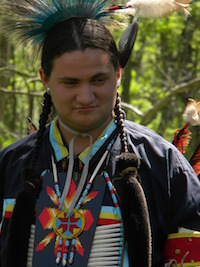 Stories of the Indigenous people matter, because the stories influences how we think about ourselves, where we come from and formulates the way in which we think about cultural perspectives and people.
Stories of the Indigenous people matter, because the stories influences how we think about ourselves, where we come from and formulates the way in which we think about cultural perspectives and people.
The one element inherent in Stories Matter is Storytelling. Storytelling, in Indigenous narratives, involves the origins of identity, knowledge systems, and ways of knowing and being, as told by the elders and embraced by members of that community. The oral traditions are utilized to convey, across generations, all that we are and hope to be. I believe one of the most important learning outcomes we hold as a culture is for our children to conduct themselves as Indigenous people, with dignity and respect for all things, and especially to their elders. In the Indigenous culture, the elders are our teachers and professors; the knowledge they have gained throughout the course of lifetimes is important to pass on to the next generations.
I have created a text set of Indigenous Children’s literature, the first is from the Southwest Region of the United States. Within the literatures are Stories from mainly Native Authors and Native Illustrators.
 The Flute Player: An Apache Folktale (Lacapa, 1990).
The Flute Player: An Apache Folktale (Lacapa, 1990).
The story is about an Apache boy and girl who like each other. The Apache boy plays his flute for the girl and the girl places a leaf in the river demonstrating she likes his playing. The boy goes hunting and the girl gets sick and . . .
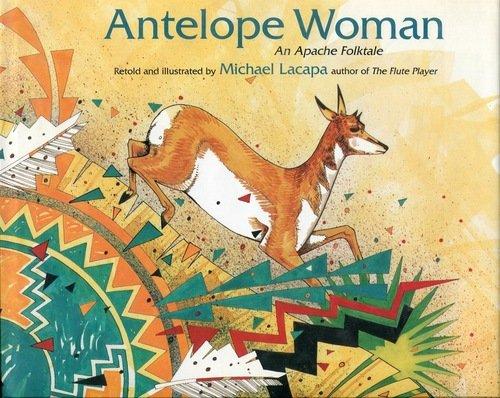 Antelope Woman: An Apache Folktale (Lacapa, 1992).
Antelope Woman: An Apache Folktale (Lacapa, 1992).
The story is about a beautiful Apache maiden who follows the mysterious young Apache man who has come to the village to teach her people to respect “all things great and small.” She becomes his wife. The story is derived from traditional White Mountain oral stories, which is the way Apache philosophy and elements of Apache culture are inter-generationally shared with Apache children from an early age through the introduction and repetition of narratives. The narrative content stresses the importance of respect for all living things.
NDee Benadgode’i: The Three Stories of the White Mountain Apache Tribe (Adley & Lacapa, 1981). The book contains storytelling timetable, as well as details on the preparation for storytelling. The first story, The Cooking Stick, depicts how the Apache people were already living in the world until one day a war and exodus started. They had a Spirit who help them through the Head Crown Dancer and through two children who were left behind. The cooking stick spirit helped the boy and girl survive. The second story, Old Big Owl Witch, is a story of how naughty children were taken by this Owl Witch. The third story, Spider Helps Robin, is a story of how Spiders helped a baby robin return to his nest in the tree. These stories reflect the White Mountain Apache philosophy which stress that there is a proper time for everything. There is an appropriate time of year for certain types of storytelling.
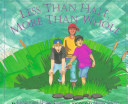 Less Than Half, More Than Whole (Lacapas, 1994). The main character, Tony, notices that his skin is darker than yellow-haired Scott’s, but lighter than that of his Native American friend, Will. This story is describes the experiences of a couple in a multicultural marriage and their children’s struggle for identity.
Less Than Half, More Than Whole (Lacapas, 1994). The main character, Tony, notices that his skin is darker than yellow-haired Scott’s, but lighter than that of his Native American friend, Will. This story is describes the experiences of a couple in a multicultural marriage and their children’s struggle for identity.
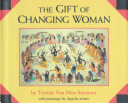 The Gift of Changing Woman (Seymour, 1993), with Apache illustrators. This story focuses on the ceremony of an Apache girl who goes through her puberty dance, the “Sunrise Dance,” and how it is conducted.
The Gift of Changing Woman (Seymour, 1993), with Apache illustrators. This story focuses on the ceremony of an Apache girl who goes through her puberty dance, the “Sunrise Dance,” and how it is conducted.
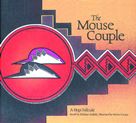 The Mouse Couple (Malotki, 1980) illustrated by Lacapa. The story is about a father mouse searching for a husband for an industrious daighter. He went in all the four directions: sun, clouds, winds, and butte. But he was sent back to his own kind to search for the husband.
The Mouse Couple (Malotki, 1980) illustrated by Lacapa. The story is about a father mouse searching for a husband for an industrious daighter. He went in all the four directions: sun, clouds, winds, and butte. But he was sent back to his own kind to search for the husband.
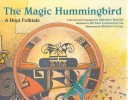 The Magic Hummingbird (Malotki, 1996) illustrated by Lacapa. The Hummingbird in the story assists two young children in surviving a drought and later helps their people. The two young children learn the importance of staying in contact with the source of creation symbolized by the hummingbird.
The Magic Hummingbird (Malotki, 1996) illustrated by Lacapa. The Hummingbird in the story assists two young children in surviving a drought and later helps their people. The two young children learn the importance of staying in contact with the source of creation symbolized by the hummingbird.
 The Good Rainbow Road (Ortiz, 2004) illustrated by Lacapa. The story consists of two boys who were chosen by their people to visit the Shiwana, the Spirit of rain and snow. They must bring back water to relieve the drought.
The Good Rainbow Road (Ortiz, 2004) illustrated by Lacapa. The story consists of two boys who were chosen by their people to visit the Shiwana, the Spirit of rain and snow. They must bring back water to relieve the drought.
 Bidi (Thomas, 2000) illustrated by Begay, and translated by Redhair. The story is about a Navajo boy named “Bidi” who tends to get into trouble by not listening and showing off. He learns the hard way to be good listener and respect others.
Bidi (Thomas, 2000) illustrated by Begay, and translated by Redhair. The story is about a Navajo boy named “Bidi” who tends to get into trouble by not listening and showing off. He learns the hard way to be good listener and respect others.
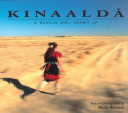 Kinaalda’ (Roessel, 1993) with photographer Doris. The story is about Celinda McKelvey, a Navajo girl, who participates in the Kinaalda’, the traditional coming-of-age ceremony of Navajo people.
Kinaalda’ (Roessel, 1993) with photographer Doris. The story is about Celinda McKelvey, a Navajo girl, who participates in the Kinaalda’, the traditional coming-of-age ceremony of Navajo people.
 Sun painter (Whitethorne, 1994). The story is about Kii Leonard, as he experiences a total solar eclipse. He witnesses the magic of the Little People and learns how to show respect for Mother Earth in the Navajo Way.
Sun painter (Whitethorne, 1994). The story is about Kii Leonard, as he experiences a total solar eclipse. He witnesses the magic of the Little People and learns how to show respect for Mother Earth in the Navajo Way.
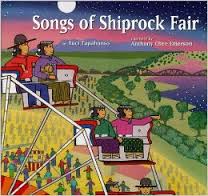 Song of the Shiprock Fair (Tapahonso, 1999) illustrated by Emerson. The story is about the experience of the Shiprock fair through the eyes of a Navajo child.
Song of the Shiprock Fair (Tapahonso, 1999) illustrated by Emerson. The story is about the experience of the Shiprock fair through the eyes of a Navajo child.
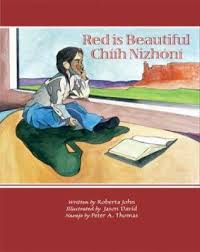 Red is Beautiful: Chiih Nizhoni (John, 2003) illustrated by David and translated by Thomas. The story is about a Navajo girl who is teased because she has a chiih (chappy) face, but her Grandmother helps her overcome the teasing of her fellow classmates.
Red is Beautiful: Chiih Nizhoni (John, 2003) illustrated by David and translated by Thomas. The story is about a Navajo girl who is teased because she has a chiih (chappy) face, but her Grandmother helps her overcome the teasing of her fellow classmates.
This is just a few of stories of the Southwestern Indigenous nations and the following week will highlight another text set of Indigenous Children’s literature from another region of the United States. Thank you.
Please visit wowlit.org to browse or search our growing database of books, to read one of our two on-line journals, or to learn more about our mission.
- Themes: Angeline Hoffman, Indigenous
- Descriptors: Books & Resources, WOW Currents
